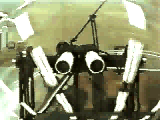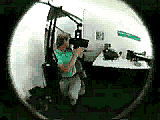

Click to view larger version
The Telepresence
Mobile Robot System
SYSTEM OVERVIEW
The Telepresence Mobile Robot System enables a visitor to see through
the eyes of a robot. Whether stationary or fully mobile (see options
A & B) the telerobot is equipped with two camera "eyes", the output of
which is displayed on a specialized viewer.
The basic telerobot system has three primary components: a computer-
controlled stereo camera system, a fixed-mount viewer, and a
communications/interface package. From a fixed viewing location,
users see a life-sized, stereoscopic image of a remote location from
the viewpoint of the telerobot. The viewpoint of the telerobot is
controlled by means of a head- coupled viewer. As the visitor moves
the head-coupled Binocular Omni- Orientation Monitor (BOOM) viewer,
the "eyes" of the camera platform are likewise oriented providing the
visitor with a persepective from the telerobot point of view.
Optional modifications to the telerobot are available that can provide
the ability for the visitor to explore a remote location and to
interact with other visitors. This includes a battery-powered,
mobility platform for the telerobot that users can control through a
simple joystick interface. Additional features can be added to provide
wireless communication between viewer and telerobot, and a custom
optical dome surrounding the camera system to ensure safe operation in
the remote environment. In all configurations, additional color video
monitors can be located in the installation for other participants to
observe the telerobot's changing viewpoint.

QuickTime Movie - 1.5M
TELEROBOT: BASIC FEATURES
- Camera System
- Two lightweight color CCD cameras
- Wide-angle, orthoscopic lenses matched to viewing lenses
for correct size and scale representation
- Computer-controlled three degree of freedom camera
platform with performance to match typical head motion speed and
dynamics
- Viewer
- A fixed-mount telepresence-viewer support with six degrees
of freedom and optical encoder-based tracking capability for viewpoint
control
- A telepresence viewer with wide-angle, orthoscopic lenses
and high- resolution monochromatic or Color CRT displays
- Communications/Interface Package
- 386-based host computer to communicate viewpoint
information between the telepresence viewer and the camera system
- Control software to support viewer/camera communication
- Intercom system for communication between viewer and other
visitors in the entertainment center
- Cable communications link between viewing station and
remote camera

QuickTime Movie - .8M
TELEROBOT: OPTIONAL CAPABILITIES
Features that can be added to the system at additional cost:
A. Mobility Platform
- A platform to support smooth camera-system movement at a constant
speed to facilitate location in the remote environment
- A platform designed to be structurally durable and easily moved
- Custom safety features and enclosures to protect operator and
others who may come in contact with the device
B. Wireless Remote
- Remote wireless capability which eliminates necessity for tether
cable
- Provides link for RS-232 data and stereo video signals
C. Outdoor Installation Kit
- Weatherproof housing for camera platform
D. Binaural Sound
- Binaural microphone unit mounted on remote camera system to
provide realtime, 3-D sound feedback from remote location.
E. Package Design
- Overall package design to develop personality and character of
remote system for public installation
F. User Interface Enhancements
- Computer graphics overlay technology to provide additional level
of interactivity and interest.
- Design and implementation of software for computer-based agents
and user-modeling capabilities to enhance funtionality.
Back to Telepresence Research Home Page
Back to Portola.com Home Page
All contents copyright (C) 1995 Telepresence Research, Inc.
All rights reserved
Revised: 2-20-95



